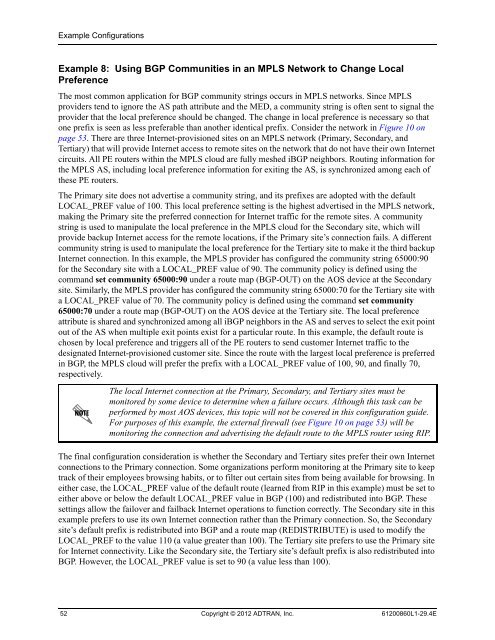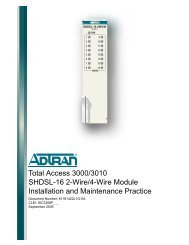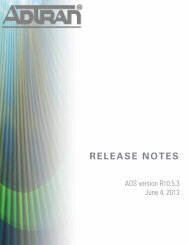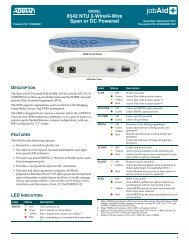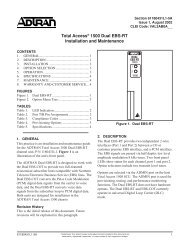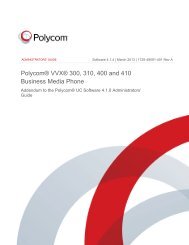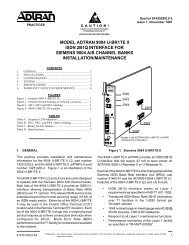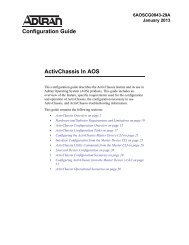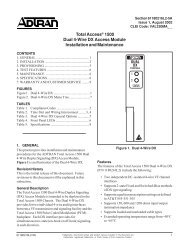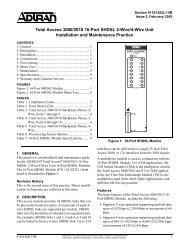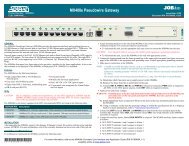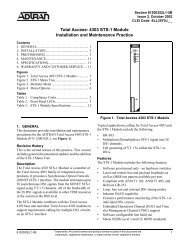View - ADTRAN Support Community
View - ADTRAN Support Community
View - ADTRAN Support Community
You also want an ePaper? Increase the reach of your titles
YUMPU automatically turns print PDFs into web optimized ePapers that Google loves.
Example Configurations<br />
Example 8: Using BGP Communities in an MPLS Network to Change Local<br />
Preference<br />
The most common application for BGP community strings occurs in MPLS networks. Since MPLS<br />
providers tend to ignore the AS path attribute and the MED, a community string is often sent to signal the<br />
provider that the local preference should be changed. The change in local preference is necessary so that<br />
one prefix is seen as less preferable than another identical prefix. Consider the network in Figure 10 on<br />
page 53. There are three Internet-provisioned sites on an MPLS network (Primary, Secondary, and<br />
Tertiary) that will provide Internet access to remote sites on the network that do not have their own Internet<br />
circuits. All PE routers within the MPLS cloud are fully meshed iBGP neighbors. Routing information for<br />
the MPLS AS, including local preference information for exiting the AS, is synchronized among each of<br />
these PE routers.<br />
The Primary site does not advertise a community string, and its prefixes are adopted with the default<br />
LOCAL_PREF value of 100. This local preference setting is the highest advertised in the MPLS network,<br />
making the Primary site the preferred connection for Internet traffic for the remote sites. A community<br />
string is used to manipulate the local preference in the MPLS cloud for the Secondary site, which will<br />
provide backup Internet access for the remote locations, if the Primary site’s connection fails. A different<br />
community string is used to manipulate the local preference for the Tertiary site to make it the third backup<br />
Internet connection. In this example, the MPLS provider has configured the community string 65000:90<br />
for the Secondary site with a LOCAL_PREF value of 90. The community policy is defined using the<br />
command set community 65000:90 under a route map (BGP-OUT) on the AOS device at the Secondary<br />
site. Similarly, the MPLS provider has configured the community string 65000:70 for the Tertiary site with<br />
a LOCAL_PREF value of 70. The community policy is defined using the command set community<br />
65000:70 under a route map (BGP-OUT) on the AOS device at the Tertiary site. The local preference<br />
attribute is shared and synchronized among all iBGP neighbors in the AS and serves to select the exit point<br />
out of the AS when multiple exit points exist for a particular route. In this example, the default route is<br />
chosen by local preference and triggers all of the PE routers to send customer Internet traffic to the<br />
designated Internet-provisioned customer site. Since the route with the largest local preference is preferred<br />
in BGP, the MPLS cloud will prefer the prefix with a LOCAL_PREF value of 100, 90, and finally 70,<br />
respectively.<br />
The local Internet connection at the Primary, Secondary, and Tertiary sites must be<br />
monitored by some device to determine when a failure occurs. Although this task can be<br />
performed by most AOS devices, this topic will not be covered in this configuration guide.<br />
For purposes of this example, the external firewall (see Figure 10 on page 53) will be<br />
monitoring the connection and advertising the default route to the MPLS router using RIP.<br />
The final configuration consideration is whether the Secondary and Tertiary sites prefer their own Internet<br />
connections to the Primary connection. Some organizations perform monitoring at the Primary site to keep<br />
track of their employees browsing habits, or to filter out certain sites from being available for browsing. In<br />
either case, the LOCAL_PREF value of the default route (learned from RIP in this example) must be set to<br />
either above or below the default LOCAL_PREF value in BGP (100) and redistributed into BGP. These<br />
settings allow the failover and failback Internet operations to function correctly. The Secondary site in this<br />
example prefers to use its own Internet connection rather than the Primary connection. So, the Secondary<br />
site’s default prefix is redistributed into BGP and a route map (REDISTRIBUTE) is used to modify the<br />
LOCAL_PREF to the value 110 (a value greater than 100). The Tertiary site prefers to use the Primary site<br />
for Internet connectivity. Like the Secondary site, the Tertiary site’s default prefix is also redistributed into<br />
BGP. However, the LOCAL_PREF value is set to 90 (a value less than 100).<br />
52 Copyright © 2012 <strong>ADTRAN</strong>, Inc. 61200860L1-29.4E


